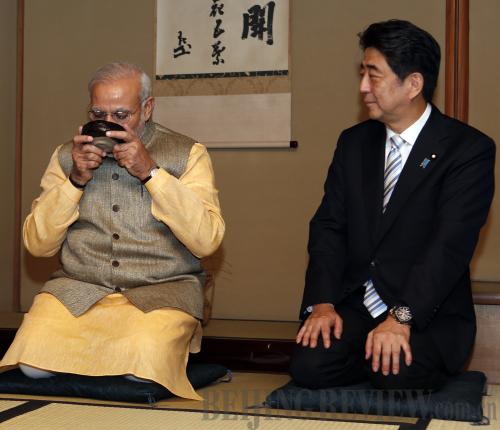|
 |
|
A CUP OF DIPLOMACY: Indian Prime Minister Narendra Modi (left) enjoys a cup of green tea next to Japanese Prime Minister Shinzo Abe at the Omotesenke in Tokyo on September 1 (CFP) |

India and Japan at first sight seem unlikely close allies. One, India, is a hugely diverse country, embracing many different languages and ethnic communities, with a modern political system born from colonial occupation under the British. The other, Japan, is an island state highly uniform in language and ethnicity that was largely closed to the outside world till the late 19th century, and which then industrialized rapidly and undertook aggressive colonial attacks on many of its neighbors. How is it possible for India and Japan to forge a common understanding of each other and a framework to cooperate in, in view of all these differences? Can they really have much in common?
Sharp focus
In fact, the visit by the newly elected Indian Prime Minister Narendra Modi to Japan in September is merely the latest installment in several decades of dialogue and understanding. For a new and ambitious leader keen to energize the economy of his country, and looking for more diverse international partnerships, Japan is not a strange choice for Modi to concentrate his attentions on. Since the late 1990s, Japanese companies have been some of the largest investors in India. The Japanese Government has granted India the largest amount of development assistance they have ever deployed abroad. In 2000, then Japanese Prime Minister Yoshiro Mori undertook a visit to India in which he talked of a closer strategic partnership. This intensified in the 2000s, culminating in the declaration in 2006 under Modi's predecessor Prime Minister Manmohan Singh of a "Joint Statement Toward Japan-India Strategic and Global Partnership."
Unpacking the full potential of the 2006 agreement was Modi's primary focus in his 2014 visit. The simple fact is that, as with China, India could do a lot better in what it achieves with the relationship. In 2012-13, India exported $6 billion to Japan, and imported $12 billion. This asymmetry is a problem. For Modi, the best strategic placement would be to have a relationship where more Japanese investment can create jobs in India, and where India is able to figure more prominently in the global supply and manufacturing chain, addressing its poor export position. With an eye to rising wages and associated costs in China, India is aware that it can emulate the Chinese model by competing with it to produce manufactured goods. Hampering this is the poor state of infrastructure that India currently has, and here too Japan can be helpful, supplying investment and know-how.
|
